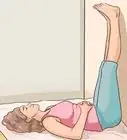This article was co-authored by Atthena Breitton, E-RYT 500. Atthena Breitton is a Yoga Alliance E-RYT 500 and Continuing Education Provider. She is the Founder & Principal Teacher of AtthenaYoga, a boutique yoga and meditation studio in New York City. She has been teaching since 2015, and some of her clients include NFL football player, Jordan Matthews, and Hip Hop Rapper, Lil Yachty. In addition to her studio, Atthena teaches and lectures around the city at major corporations such as Facebook, Ernst & Young, HSBC, U.S. Bank, and WPP. Atthena follows the path of Bhakti Yoga, a path of selfless love, devotion, and service to the Divine. Atthena holds a BS in Economics with concentrations in Finance and Management from the University of Pennsylvania.
There are 7 references cited in this article, which can be found at the bottom of the page.
wikiHow marks an article as reader-approved once it receives enough positive feedback. In this case, 100% of readers who voted found the article helpful, earning it our reader-approved status.
This article has been viewed 134,399 times.
If you're interested in yoga, you'll need a mat. Yoga mats come in a variety of lengths and textures and are made from many different materials. If you want a yoga mat, you should consider a variety of factors. Think about your personal needs, especially in regards to the type of yoga you perform. You should also think about the type of material you want. Also, think about the physical aspects of the mat, like texture and thickness.
Steps
Considering Your Needs
-
1Consider your body type. The type of yoga mat you need depends, to an extent, on your body type. If your joints get sore easily, you may need a thicker mat. Thicker mats, or mats with extra padding, can be easier on the joints. Standard yoga mats are 1/8 of an inch thick, but go up to 1/4 of an inch. Consider a thicker mat if you like more cushioning. [1]
- Keep length in mind if you're tall. A standard yoga mat is 68 inches long, which may not be long enough if you're on the taller side. Look into a super-stretched yoga mat if you're more than 5'6" tall.[2]
- Consider any injuries. For example, if you have knee issues, you might want a thicker mat to pad your knees.
EXPERT TIPEllen East is a certified yoga instructor and owner of Studio 4 WholeHealth in Hartwell, Georgia. She received her 200RYT certification from Yoga Alliance and has been a yoga practitioner for over 25 years.Yoga Instructor
 Ellen East
Ellen East
Yoga InstructorEllen East, yoga instructor, adds: "A thicker mat can be more comfortable for seated poses, but you'll want a thinner mat for standing poses and especially for balance poses. 4mm is a good thickness."
-
2Look into your type of yoga. The type of yoga you'll be doing can also affect what kind of mat you should purchase. Consider your yoga level before purchasing a mat.
- If you're new to yoga, it's okay to go with a less high-quality mat. Go for a basic mat between $10 and $20. You may decide yoga is not for you, so you do not want to invest in expensive equipment. Also, as you figure out how your body responds to yoga, you'll be better able to figure out your personal needs. Go for a cheap mat now and then choose a more expensive one down the road.
- Flow yoga classes require more complex movements, and you'll need a mat with more traction to keep your arms and legs in place. For yin classes, however, you'll primarily be sitting on the ground, so grip is less important. Instead, go for a soft, cushy mat.[3]
- Some people engage in a form of "hot yoga," in which they engage in yoga in a heated room. If you're doing hot yoga, you may want to choose a mat specifically designed for this type of yoga. These mats are designed to keep you from slipping when sweat gets on your mat.[4]
Advertisement -
3Consider where you're doing yoga. Where you're going to do yoga also makes a big difference in your mat type. If you intend to primarily do yoga at home, for example, you do not need to worry about a lightweight mat you can transport easily. However, if you take yoga classes outside your home, you may want to look into a mat you can carry around easily.
- You may also want to look into a lighter weight mat if you travel a lot and do yoga when on the road. You may also want to consider investing in a second yoga mat that you can bring on trips.
Choosing a Material
-
1Be wary of PVC mats. Polyvinyl Chloride (PVC) is one of the most commonly used materials to make yoga mats. However, it has a bad reputation in the yoga community as some studies indicate it may be a carcinogen. It is also hard to recycle. In the event your mat gets old and worn out, you'll simply have to throw it away. If you're a health-conscious person, you may want to avoid a PVC mat.[5]
-
2Try a rubber mat. Many people prefer mats made out of natural rubber to PVC mats. A simple rubber mat is about as easy to find as PVC mat, but has a better reputation among yoga enthusiasts.[6] A rubber mat may be a good idea if you're just starting out, as they're simple to find and somewhat inexpensive.
-
3Use a padded mat. Padded mats are a lot softer and more comfortable than regular yoga mats. A padded yoga mat is made of two parts: an inside portion, made of foam, and an outer removable cloth covering.[7]
- These mats can be great for yoga that involves a lot of sitting or lying down. They generally provide a lot more support than the average mat. However, they do not provide a lot of grip. You may find yourself slipping and falling during certain poses when using a padded mat.[8]
- One downside to padded mats is that they can only be partially washed. You can wash the outer cloth layer, but the internal foam is non-washable.[9]
-
4Look into cotton. Some yoga mats are simply made of cotton. Many prefer cotton because it's a more natural material.[10] While cotton may retain more sweat, it is easily washable. It is also soft but may have slightly more grip than a padded mat. However, cotton can more easily retain sweat. A cotton yoga mat may require frequent washing.
-
5Consider a non-slip mat. Non-slip mats, also known as sticky mats, are mats designed to allow you to move into many different positions. These mats provide added grip and stick. If you're doing a particularly rigorous form of yoga, consider a non-slip mat.[11]
- Sticky mats typically can't be laundered in a washing machine. You can easily clean them with a special spray or wipe, though.[12]
Considering Other Aspects of the Mat
-
1Consider texture. The texture of your mat makes a difference in terms of your personal comfort. Mats come in a variety of textures, so make sure you consider texture carefully before making a choice.
- Stickier mats, like non-stick mats, tend to have a rougher texture. While this can irritate the skin, it can actually be an advantage if you're doing yoga that involves a lot of intense poses.[13]
- If you prefer a smooth mat, PVC mats may be the best way to go. However, many yoga supply companies sell more eco-friendly mats that offer a smooth texture. Try looking into a company with a reputation for being environmentally conscious if you want a smooth, non-PVC mat.[14]
-
2Choose a mat that's appropriately thick for your needs. As stated, if you're new to yoga, you'll need more padding. Most standard yoga mats are 1/8 of an inch thick, which may not be thick enough for a beginner. However, yoga mats can be as thick as 1/4 of an inch. If you need more padding, consider going for a thicker mat.[15]
- A good in-between would be a mat of 1/6 of an inch. If you're new to yoga but more petite in frame, this may be a good option for you. A mat of in-between thickness may also be good if you travel a lot, as they're easier to roll up and transport.
-
3Pick a mat that's easy to store. It can be cumbersome to have a yoga mat that's difficult to roll up. Go for a mat that's made of lightweight material and rolls up easily. Test out a mat in the store by rolling it up a few times. Make sure the mat is easy to maneuver so you will not have to worry about storing it.
-
4Consider accessories. Depending on your needs, you may need certain accessories for your yoga mat. A handle may be a good idea if you travel to yoga each day. You may also want to purchase a carrying case for your mat, as well as a cotton buckle to secure your mat when you roll it up.
- You might want to invest in a cleaning spray or wipe to clean off your yoga mat when you're done using it.[16]
EXPERT TIPEllen East is a certified yoga instructor and owner of Studio 4 WholeHealth in Hartwell, Georgia. She received her 200RYT certification from Yoga Alliance and has been a yoga practitioner for over 25 years.Yoga Instructor
 Ellen East
Ellen East
Yoga InstructorEllen East, yoga instructor, tells us: "It's a good idea to wipe your mat down after each use, using a purchased mat cleaner, plain water or a DIY mixture — typically made from witch hazel, water and essential oils."
-
5Look into price. Yoga mats vary greatly in price. A 1/8-inch thick PVC mat with no padding, stickiness, or other frills will be your cheapest option. You can get a mat of this nature for around $10, but it will wear out fast. If you're serious about yoga, consider investing in a higher quality mat.[17]
- If you plan on doing yoga longterm, go for a pricier mat from a reputable sports or yoga company. A mat from Lululemon Athletica, for example, may be a worthy investment if you're a yoga enthusiast.
- Certain features, like padding and stickiness, do cost extra. However, if you've decided these extras are important to you due to your personal needs, they may be worth the extra price.
How Can I Set Up A Space In My House For Yoga?
References
- ↑ http://life.gaiam.com/article/how-choose-right-yoga-mat
- ↑ http://greatist.com/fitness/how-buy-right-yoga-mat
- ↑ http://www.outdoorgearlab.com/Yoga-Mat-Reviews/Buying-Advice
- ↑ http://kristinmcgee.com/how-to-choose-the-right-yoga-mat-a-ton-of-options-to-choose-from
- ↑ http://www.huffingtonpost.com/2015/05/03/yoga-mat_n_7182330.html
- ↑ http://www.huffingtonpost.com/2015/05/03/yoga-mat_n_7182330.html
- ↑ http://www.burrenyoga.com/choosing-a-yoga-mat/
- ↑ http://www.burrenyoga.com/choosing-a-yoga-mat/
- ↑ http://www.burrenyoga.com/choosing-a-yoga-mat/
- ↑ http://life.gaiam.com/article/how-choose-right-yoga-mat
- ↑ http://www.burrenyoga.com/choosing-a-yoga-mat/
- ↑ Atthena Breitton, E-RYT 500. Yoga Instructor & Educator. Expert Interview. 4 March 2020.
- ↑ http://life.gaiam.com/article/how-choose-right-yoga-mat
- ↑ http://life.gaiam.com/article/how-choose-right-yoga-mat
- ↑ http://life.gaiam.com/article/how-choose-right-yoga-mat
- ↑ Atthena Breitton, E-RYT 500. Yoga Instructor & Educator. Expert Interview. 4 March 2020.
- ↑ http://greatist.com/fitness/how-buy-right-yoga-mat
About This Article
To choose a yoga mat, start by choosing a thicker mat if you’re slim or have a small frame, or a thinner mat for a more robust frame. Additionally, choose a thicker mat if you get sore joints, since they provide extra support. Next, pick between a regular mat made of rubber or cotton, and a non-slip mat, which will give you more grip for rigorous forms of yoga. If you're doing a type of yoga that involves a lot of sitting or laying down, try a padded mat for better comfort or support. For more advice, including how to pick the perfect mat for hot yoga, read on!

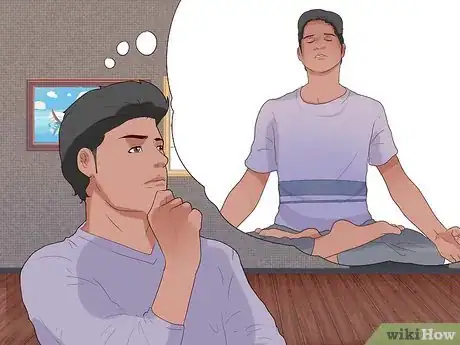
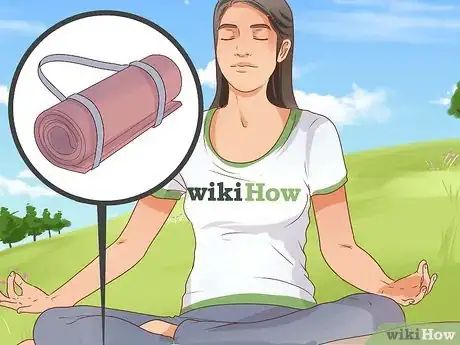
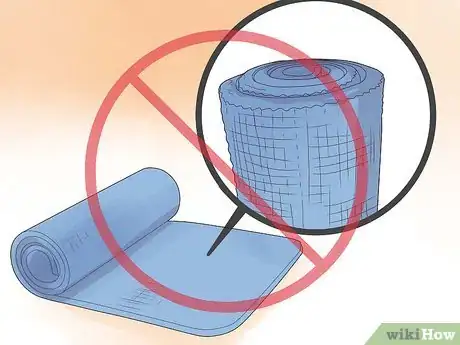
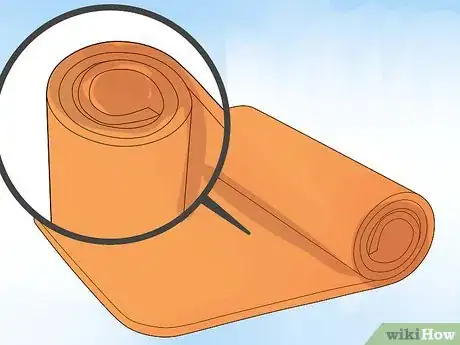
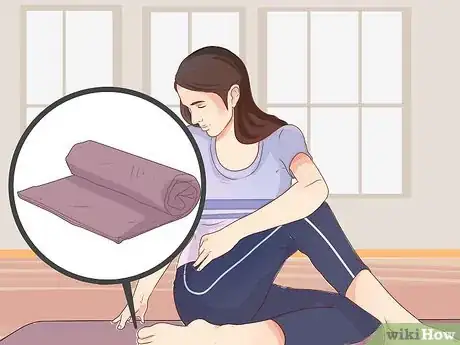







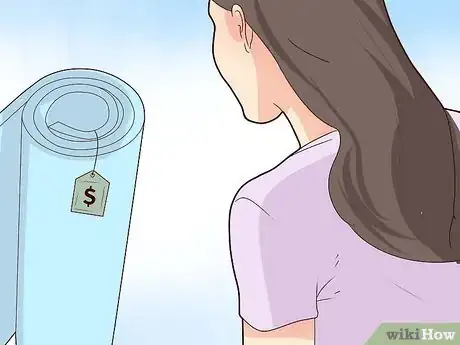
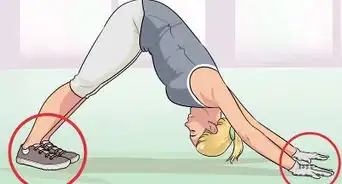





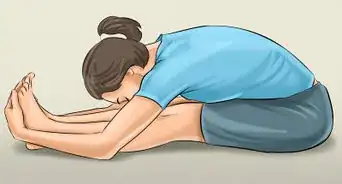





-Step-16.webp)













